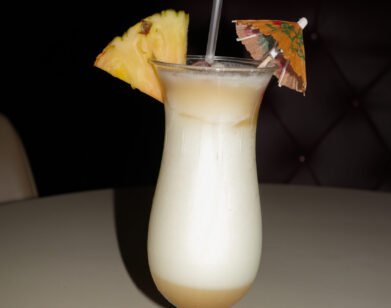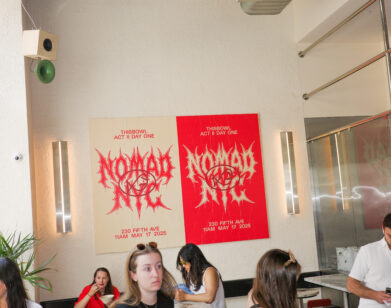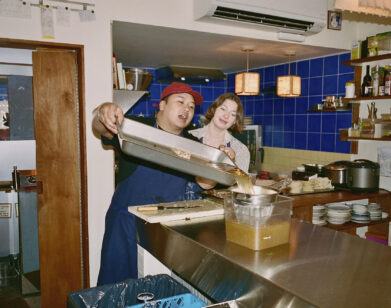COOKED
Enrique Olvera Just Wants a Good New York Taco

Enrique Olvera is deep, grounded, and warm. He has a wisdom and an ease that come with age, and having seen the mountaintop. A lazier writer might compare him to his famous mole, which I ate this week at Pujol’s residency at WSA. The mole has been maturing for over 3,000 days, and was complex in ways that I didn’t know were possible—it was deep, grounded, and warm. Enrique, of course, is the chef/owner of Pujol, a restaurant that, more than any other, put contemporary Mexican cuisine on the map. This year marks the 25th anniversary of Pujol, and in that time, Enrique has received every possible accolade a chef could ever want. Now he’s looking forward, and he’s also looking back. He’s not slowing down just yet, but he’s ready to have some fun.
———
J LEE: Thank you so much for taking the time.
ENRIQUE OLVERA: Thank you for giving me a break.
LEE: So you’re bringing Pujol to New York? Is it Pu-yol or Pu-hol?
OLVERA: We pronounce ourselves “Pu-yol,” but we don’t take it seriously, so you can pronounce it whichever way you want. Some people make fun of the name because it sounds like “poo hole.”
LEE: Why is it called Pujol?
OLVERA: It’s a nickname that I got when I was in high school. It doesn’t have meaning. It’s a name. The meaning of it is like a small hill in Catalonia, but it really doesn’t have meaning; it’s just a proper name. It’s something that we’ve always liked for restaurants. Cosme is just a name. Damián is just a name. Pujol is just a name. Imagine if a restaurant was called John, it would be great, right?
LEE: Yeah, it would be great. So Pujol is 25 this year. And then it’s also been 10 years of Cosme this year, right?
OLVERA: Yeah. We’re getting older, man.
LEE: It’s crazy.
OLVERA: We’re getting older. I feel like we’re in a good place now, a little bit more calm. It feels like we’re in a place that we can enjoy ourselves now and do things that we really love to do, like this pop-up with Resy at WSA. I think we’ve had the recognition that we never actually dreamed of, so much recognition. So it’s more like now trying to use that blessing to do things that are amazing instead of pursuing more.
LEE: Another thing that was 10 years ago now is your Chef’s Table episode. I remember you saying that you should have as much fun cooking as you have eating. I love that. It really resonated with me. Sometimes you go to a restaurant and you can taste that they’re not having fun.
OLVERA: Yeah. For example, I like jogging now. And when you’re jogging for fun, your stride is very easy, and you’re listening to music, and now you’re watching the sunrise and breathing the air. Some people are running and they’re really struggling, nd I think the more at ease you are, the easier it is to have fun doing it. But to be able to have fun doing it, you have to be in the rhythm. You have to have a lot of practice. And 25 years is a lot of practice. This is also one of the reasons that we’re able to enjoy it. I like this analogy that cooking is a little bit like theater, that you’re doing it every day. Of course there are good days and bad days, but if you’re having fun and enjoying it, you most probably would have a lot more better days than if you’re very uptight and nervous.
LEE: I spoke to Mario Carbone last week. He talks a lot about theater. Do you feel like you are the ringleader of a circus, or the director of a play?
OLVERA: Mario’s restaurant group is very theatrical. I love The Grill. It’s one of my favorite restaurants.
LEE: It’s the best restaurant.
OLVERA: But I do agree that restaurants are like a choreography. In that sense, no, your restaurant doesn’t need to be theatrical, but if you have really good preparation, then you can enjoy the play, right? Even if you’re acting. If your preparation sucks, you’re probably not enjoying the play. I see it more, I think, from a dynamic perspective. The idea is also that you have a whole experience. Obviously the food must be so precise, so simple, that people should want to know how you did it. I always tell the waiters, we shouldn’t explain. People should ask for explanations.
LEE: It’s a magic show.
OLVERA: Imagine you go into a restaurant and then the waiter gives you a huge explanation of the dish. You taste it and you go, “Oh, okay.” The difference is, sometimes when I travel in these small towns in Mexico, I have a very simple soup in a very humble house up in the mountain, and you taste it and you go like, “What did you put in this?” And they go like, “Nothing. Just garlic, onions, and some leaves.”
LEE: Is it just the ingredients?
OLVERA: It’s the quality of the ingredients, their exposure to the sun. That’s the difference between a great tomato soup and an average tomato soup. It’s the tomatoes. We as cooks, we’re not magicians.
LEE: You’re alchemists a bit, at least.
OLVERA: Yeah. I cannot make the best tomato soup if I don’t have good tomatoes. Even if I can put spices and make it taste like something else, it won’t make it a great tomato soup. If you want the best tomato soup, you need good tomatoes. And in order to get good tomatoes, you need for them to mature on the plant and to have amazing soil.
LEE: So you’re doing this pop-up at WSA, you’re out of your element. I know that you are very familiar with New York, but this is a whole new space, certainly lots of new staff, new silverware, new produce purveyors. One, how do you try to translate your choreography of the dining room to a space like this? Do you build a new choreography? Two, your cooking is so ingredient-driven, and I’m sure there are some things you can’t get here in New York, so how do you reconcile those things and try to make something that feels like you and like Pujol?
OLVERA: Pujol moved to a new location in 2016, and the old location was pretty much this exact same size as our space at WSA. So we tried to mimic the original location of Pujol. The dining room over there was also black and white, so we did everything black and white. The staff is dressing the same way we used to dress in the early years, which is like a black-on-black tie. As far as cooking, we’re doing dishes that I think work both for Mexico and New York. And then we’re switching the ingredients so that we are using local products.
LEE: So are you doing the mole?
OLVERA: We’re doing the mole, that we brought all the way from Mexico. Thank god. They’ll kill me if we don’t do it.
LEE: In the past year specifically it’s gotten a lot better, but I’ve never quite understood why New York doesn’t have a lot of great Mexican food.
OLVERA: I think it’s bad corn. And I think also it was lack of understanding on how to make the adjustments. You’re going to have to make some adjustments. Talking about authentic tacos is always a very tricky conversation.
LEE: Any kind of idea of authenticity is always going to be led by someone that’s annoying.
OLVERA: And tacos are so diverse. They have so many different backgrounds. And you can make a taco almost out of anything. You see tacos in New York that say they’re authentic Mexico City tacos, which doesn’t really mean much. I would love that there would be New York-style tacos, kind of like with American pizza styles, like deep dish. So maybe, hopefully instead of saying, “Oh, we’re doing Mexico City tacos in New York,” we’re doing New York tacos with great corn. California has its own Mexican, there’s TexMex. I think we need New York Mexican.
LEE: Yeah, that’s true. I’m trying to think what my definition of New York-Mexican would be. What’s a New York-Mexican burrito?
OLVERA: You would have to see what the street food looks like in New York and work from there.
LEE: Yeah, maybe. I hope it doesn’t have to be Halal Guys in a burrito form.
OLVERA: Pretzel burrito.
LEE: Everything’s spiced.
OLVERA: We have to figure it out.
LEE: We’ll figure it out.
OLVERA: We’ll try to make it fun, too, because tacos should be fun. It’s fun to eat, democratic.
LEE: I feel like we are only scratching the surface of the diversity of tacos here. It’s getting better, but I really would love to see more.
OLVERA: And who has done a great job, and sometimes he doesn’t get the recognition with tacos, is (Alex) Stupak. Stupak has done some very interesting tacos. He did a hamburger taco once. I think he’s a very creative and an amazing guy.
LEE: So is the taco defined by just the vessel? Could you have a rice paper taco?
OLVERA: You could.
LEE: Would a spring roll be a taco?
OLVERA: Yeah, of course. I think pizza is a lot more purist than tacos. We were discussing the other day, you can mess up a lot. I mean, you can be a little bit creative, but nobody gets crazy creative with the filling of a pizza.
LEE: Yeah. I’m from Chicago. We get a little too creative with that.
OLVERA: The most creative is a Hawaiian-style pizza.
LEE: That’s pretty good.

OLVERA: But with a taco, I think you can get creative with the flour. No, you can do yucca, you can do wheat. You can do rice paper like you said. I personally like the fillings to be very simple. And then with the salsas, you can get crazy creative.
LEE: I read an article recently that was saying the hallmark of Mexico City tacos is the minimalism of the toppings.
OLVERA: Most taquerias that are old school do tend to be very simple. And also they never combine styles. So if you’re doing carnitas, it’s only carnitas. If you’re doing al pastor, it’s only al pastor. Modern places have been getting a bit more creative.
LEE: I’m guilty of being a huge Orinoco fan. It’s so good.
OLVERA: Orinoco is great, especially at night.
LEE: I only go after some tequila or whatever.
OLVERA: It’s good. It’ll knock you out.
LEE: Yeah.
OLVERA: Completely. Yeah.
LEE: In these 25 years of Pujol, even in the 10 years since Cosme opened, Mexico City has changed so much. How do you think the city has changed, and how has it impacted your restaurants?
OLVERA: It has become more cosmopolitan, not only because of tourism, but because of the people that are living there. I think this is a great thing for Mexico City. One of the beauties of Mexico City is that it’s very layered. You see the pre-Hispanic Mexico City, the colonial Mexico City, the French influence from the Porfirio days, and then you see the modern Mexico. Adding another layer of cosmopolitan people and restaurants and culture, I think is great for the city.
LEE: I’ve heard people have been critical of how expensive things are getting.
OLVERA: Yes, in certain places. But for example, Colonia Roma was a place of mansions in the Porfirio Díaz Ages. It’s saying like you’re gentrifying Central Park. That was one of the richest areas in Mexico. So we have to also be a little bit careful.
LEE: It also has to do with a lot that Americans who don’t understand the economics of Mexico. There is wealth, but there is also a class divide.
OLVERA: It’s a fact that it’s getting very, very expensive. I don’t think it’s because people are moving there. I think what’s happening is that in Mexico, everybody’s pushing the prices. Not the tourists, everybody.
LEE: So, after all the change in Mexico City, and 25 years of Cosme, what do you do now?
OLVERA: We’re trying to do what we love the most, which are things like this pop-up at WSA. We’re also doing a pop-up where we’re making conchas. I’m going to Copenhagen in December to cook for a block party. Next year, we’re opening a taco counter in Mexico City.
LEE: Lots of things.
OLVERA: Yeah. The Pujol menu now changes entirely every four months, and we’re doing different regions of Mexico. So right now we’re in the Maya, so it’s like Yucatán, Quintana, Campeche, Tabasco. Next season will be Oaxaca. So we’re changing the menus and then also doing a loop. Being able to come back to the dishes is so important, because there’s a learning that sometimes you discard if you change the menu all the time. I think every time you come back to the dishes, it’s an opportunity to make it better.
LEE: I used to be an artist, and I think sometimes I look back on my old work and I’m like, “What the fuck was I thinking? What is this? I hate it.” Do you feel that way about your old dishes, or do you look back at all of them fondly?
OLVERA: Yeah, some of them. And some of them I also go like, “This was great.” I think 90 percent you feel ashamed, and then 10 percent you go, “Oh, that was genius.” So hopefully the next, I’m not going to say 25, because I don’t want to work 25 more years, but say the next 10 years would be about repetition. 10 years, and then I’m out.
LEE: Ten years?
OLVERA: Yeah. I don’t want to work till I’m 70. I don’t have that personality. I mean, probably after 60, not retired, but yes, at least working minimally.
LEE: Puerto Vallarta?
OLVERA: Maybe more a farm.
LEE: A farm.
OLVERA: Yeah.
LEE: That’s fun. What do you want to grow?
OLVERA: Yeah, maybe a place in Oaxaca. Just have a very simple life. And I wouldn’t produce anything commercially. It would be just for me, my family. A few dogs, maybe some grandchildren.






